Amidst the continued clashing viewpoints on drag artist Pura Luka Vega’s daring rock rendition of “Ama Namin,” DAKILA members Floyd Scott Tiogangco, a queer performance artist and Keneth Gadian, a Catholic seminarian sit down to ask, answer, and ruminate on the burning questions that surround the controversial drag performance.
Written by Precious Marie Gunayon of DAKILA
More than a month after it went viral, the Ama Namin rock version performance of drag artist Pura Luka Vega continues to ignite passionate and polarizing opinions from the public, ranging from opposition to support, each colored by personal background and lived experiences. The impact of this controversy is also no longer contained in social media but has gained traction in the halls of power. Senators have voiced their disapproval, labeling the performance as “disrespectful,” “offensive,” and outright “blasphemous.” At the same time, at least 11 local government units have declared Pura Luka Vega persona non grata or unwelcomed in their localities. On the other hand, the LGBTQIA+ community and artists stand firmly behind Vega, viewing the act as artistic self-expression against a backdrop of perceived suppression by the Church.
It is no question that a lot has already been said about the controversy. But amid the cacophony of clashing opinions, most of which are delivered with animosity, something seems to remain missing: an open and respectful discussion between the members of the LGBTQIA+ and religious communities who confront on personal and societal levels these multi-layered issues on beliefs, rights, and freedoms. In an attempt to express where they are coming from while forging a better understanding of the other, two members from different sides of the spectrum sat down and engaged in a seemingly impossible dialogue: DAKILA members queer performance artist Floyd Scott Tiogangco and Catholic seminarian Keneth Gadian.
Blasphemy or not? A differing instinctive take on the performance
The stark difference between how the two felt when they first watched the controversial video mirrored the polarizing reactions to the contentious issue.
Coming from a strong religious background, Keneth naturally shares the sentiment with the majority who felt offended, stressing the sensibilities of Catholics on what they consider sacred. “It felt off. I felt disturbed when I saw it,” he said. “I am a Catholic, I believe na this is a very personal, sacred and respectable prayer and then I see na may ibang tao na complete opposite yung treatment dito from how I would want it to be treated.”
Meanwhile, Floyd, who uses performance art as a protest against various societal issues, outrightly said that they liked the performance. “There’s nothing new with performances using religious elements but do I think a performance tackling religion needs to be done now, especially by someone who is queer? Yes. Do I think the performance was blasphemous? I don’t think so.”
They also expressed more interest in the performance’s political motivations rather than whether it is offensive or not. “Ang basa ko, gustong ipakita ni Luka na ang drag ay isang platform to express who you are that most religious people are not aware of existing. Historically, ang drag ay naipanganak for the same reason na kailangan namin sa LGBTQIA+ community ng platform that is ours to express ourselves, dahil ilang taon na kaming hindi pinapakinggan ng lipunan.”
The contrasting viewpoints, however, were welcomed by two with intentional curiosity rather than confrontation. “Maganda lang din na iba yung take mo Floyd na for you hindi siya blasphemous kasi it reminded me na nanggagaling tayo from two different places,” the seminarian started. “May bago akong picture na nakita when you shared yung background nung performance. Hindi lang pala siya ganun ka simple na they are having vulgar fun but it could be na the performance itself is meant to say something so meaning maaring purposive ang paggamit ng mga pieces that will disturb people kasi yun yung point. I still wish na hindi ginamit ang Ama Namin pero I’m starting to see na pwede nga na it’s not just a mindless party gimmick. Merong context, merong unique history at unique experience ang mga nagda-drag that I may not fully understand.”
Floyd also offered an artist’s perspective and commented on the performance itself. “Interested din ako had the performance been done in such a way na hindi party-type and not showing gestures of “mockery” like an Ama Namin ballad. I think mas interesting ang magiging take ng mga tao. Mas nakakauga ‘yun spiritually dahil mas introspection siya than division. For some extent, kailangan naman ng works that call a spade a spade to clear things out, dahil marami pa ring confused. Pero ‘di ba mas mainam na the work that we do does not only reflect what has already been said and done, but actually blurs then shapes the narratives with unfamiliar nuances and possibilities. Papasukin natin sila saka natin sila ugain.”
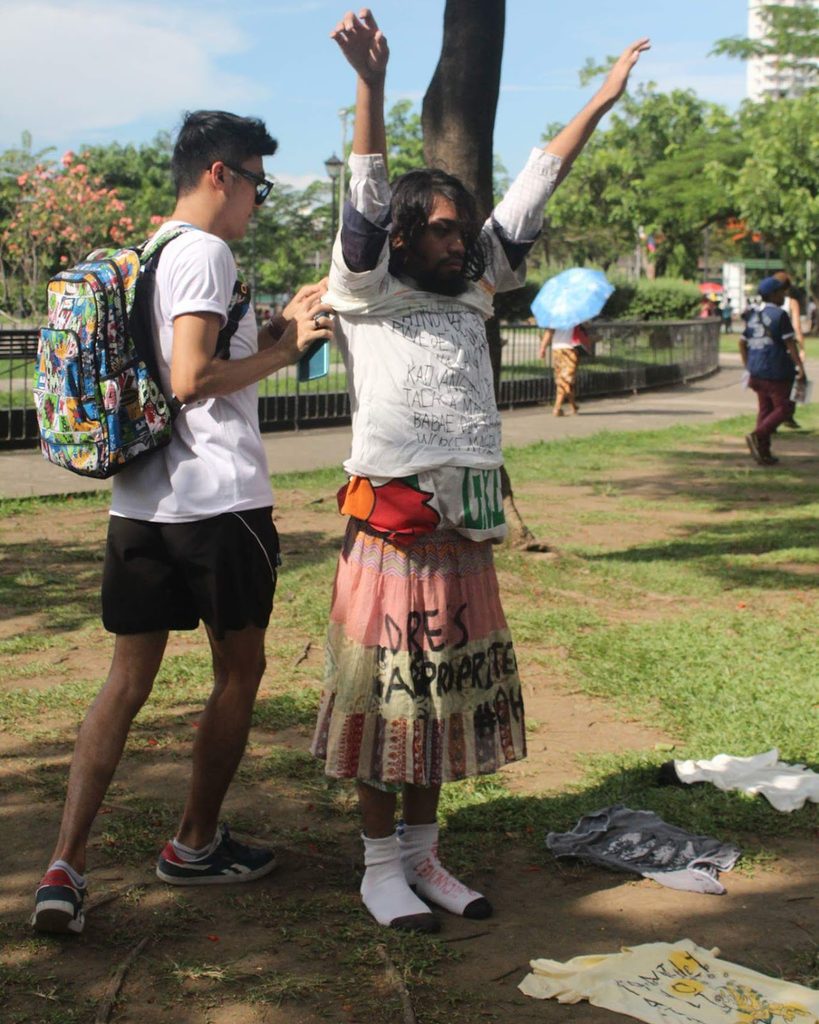
Inherent tensions between the Church and the LGBTQIA+ Community in a supposed “gay-friendly” country
Despite being a profoundly Catholic country, the Philippines has interestingly been regarded as the most gay-friendly nation in Southeast Asia in the Global Acceptance Index. This already surprising data, however, is put again into question due to the controversial performance.
“I think one of the major reasons why it blew up like that among religious people is that a queer person did the performance. Imagine someone who is not queer kahit hindi pa siya naka-drag using the Ama Namin remix, ang tanong ko ganito din ba kalaki ang magiging backlash?” Floyd said.
It can be noted that even before the rock rendition of Ama Namin, videos of Ama Namin remix have long been making rounds in the social media, gaining more laughter than rage. Even Former President Rodrigo Duterte’s remark that God is “stupid” didn’t receive as much outrage as the drag performance.
“I cannot in purest of my conscience as a queer person divorce yung performance ni Luka sa queerness niya kasi doon nanggagaling sa identity niya as a queer person yung buong performance,” they followed.
Keneth clarified that the issue, for him, was beyond sexuality and gender, but centered on using a sacred and profoundly personal prayer for entertainment purposes.
“Dahil ako nga ay Catholic, ako ay coming from a very specific perspective na ang tingin sa prayers like Ama Namin ay hindi lang siya text or work of art. May mga bagay na sacred,” he started to explain. “Yung Ama Namin kasi, aside sa si Jesus mismo ang nagturo nito, is one of the first set of prayers introduced to every FIlipino Catholic din kaya it has a special place in our hearts.
For many people, and indeed even for many members of the LGBTQIA+ community, sa mga most challenging parts ng life nila, it may be the prayer na kinapitan nila para malampasan ang mga yun. So as an artist, you have to take this into consideration: yung extra ‘kurot’ when you use very personal things improperly.”
Nevertheless, he acknowledged that it might have been a factor as to the gravity of hate comments against Pura Luka Vega.
“Pero reading the comments, I would say na for some people, many of them are religious, malaking factor sa pag weigh in nila na pambabastos at outrightly blasphemous yun kasi bakla ang gumawa,” Keneth started to ruminate.
“‘Di ba isang formula kung bakit disturbing ang isang art, kung bakit blasphemous siya or offensive, is when you get something very special, reserved, and beautiful, then ilalagay mo siya sa spaces na associated sa bastos, sa cheap at madumi. Kaya gusto ko ring magreflect dun sa perspective na ‘yun. I think repulsive ang dating ng act sa maraming tao dahil ang tingin nila sa mga bakla ay napakadumi, bastos, kampon ni Satanas. So they are contrasting the sacredness factor ng ginamit na kanta sa pagiging bakla ng gumawa. As a Christian, this kind of thinking offends me as much as the video. Sacred din kasi ang humanity ng bawat isa, gay man o straight. We mock God more, the more that we tear each other apart,” he added.
Widening gap between the LGBTQIA+ community and the Church: freedom of expression vs. religious freedom
Despite the similarities and differences in the takes on the issue, one thing can be agreed upon: the performance itself and the reactions from the Church and LGBTQIA+ communities only widened the gap—a stark contrast to Pura Luka Vega’s intention of healing the excluded Catholic in them.
“Mas lalong hihirap for the LGBTQIA+ community to attain the rights that we rightfully deserve after Awra and Luka’s issues, dahil tanggapin na natin na ilan sa mga nasa gobyerno ay miyembro ng religious community at sila ang number one sa history ng SOGIESC Equality Bill na laging humaharang. Kailangan din nating kilalanin ‘yun and at some point draw the line but how can we draw the line if we don’t actively recognize it?” Floyd added.
“Nahihinayangan din ako dun nga sa naging effect niya—yung unti-unti na sanang naiintindihan ng ibang groups na ang mga LGBTQIA+ persons ay hindi threat sa lipunan. Pero after nitong video medyo nag-step back nang napakalaki. Bumalik yung mga misplaced biases, ang mga prejudices na ang mga bakla ay hindi marunong rumespeto and all. Pero the gap, lumaki siya because instead of asking questions and reaching out as a response to the disturbance that we felt ay naging adversarial yung naging direction natin, naging us versus them na naman, which is sad,” Keneth said in agreement.

Rep. Geraldine Roman, the first-ever transgender member of Congress, also underscored how an action of a member of the community may affect all of its members.
The complexity of the issue revolves around the intersection of freedom of expression and religious sensitivities. Even in cases where the art in question might be unsettling or challenging, protecting artistic liberty is paramount as any potential legal actions or censorship could be a slippery slope to infringing more significant freedoms of expression in contexts already outside religion—especially in a country with a long history of bending and stretching the law for personal and political agendas.
“For me, the legal cases are forms of censorship. Hindi na lang our right to Freedom of Expression ang pinipigilang i-exercise natin. At wala ring grounds ‘yung legal cases dahil hindi naman sa place of worship ginawa ang performance at hindi rin nag-interrupt ng religious activity si Luka,” the queer performance artist, who was also the 2018 recipient of Amnesty International’s Most Outstanding Young Human Right Defender award, explained. “Yung declarations ng persona non grata, walang pangil ‘yan. Anong point? I believe no one should be prohibited to go somewhere, nasa Constitution ‘yan: Article III, Section 6 of the 1987 Philippine Constitution.”
Keneth may have reservations on the passage of the SOGIESC Bill, but he acknowledged that it didn’t give him the right to suppress others.
“Honestly, I don’t agree with everything about the SOGIESC campaign kasi hindi consistent ang ibang concepts with the Church’s teachings. Pero klaro sa akin ay it doesn’t give me the right to stop others from expressing their beliefs and their ways of being that are different from mine. Hindi reverent ang ginawa ni Luka in my conservative standards pero hindi naman yun ang requirements para bigyan siya ng human rights, diba? Dahil tao siya, meron dapat siyang access sa kanyang livelihood, sa kanyang preferred lifestyle at walang threat dapat sa buhay nya. And I have to respect that. We can’t just press legal charges against anybody who doesn’t think the way we do, especially kung wala naman talagang legal offense yung ginawa. So I am personally offended pero hindi ko siya pipigilan from expressing ng kanyang gustong i-express.”
Amidst these differing viewpoints about artistic liberties, religious tolerance, and the delicate balance between expression and belief, both highlighted the importance of protecting artistic liberty.
“I am certainly not offended by the performance and I wish it would have been done in another way but I will fight to the death na ipaglaban ang karapatan ng sining, ng writers na isulat, ng mga artist na i-perform, o i-paint ang mga gusto nilang sabihin dahil may karapatan tayong mag-express at hindi dapat yun nililimitahan in any way. Kapag nagsimula nang mag-censor, ‘pag nagsimula nang supilin at sikilin ng batas, ng gobyerno ang mga karapatan nating magpahayag, sunod sunod na ‘yan. We’ve seen this all before from ABS-CBN Shutdown to the passing of the Anti-Terror Law and so many others. Let’s do our best na bantayan ang mga ganitong sintomas ng diktaturya,” said Floyd.
“I think step one talaga yung pag-uusap, pero walang pag-uusap na mangyayari kapag nilagyan mo na agad ng gag yung bunganga ng isa,” Keneth seconded.
As the two navigated the differences setting them apart and their common grounds, they acknowledged that both communities could have handled the issue better while offering helpful and needed criticisms in the very community they belong to.
While maintaining that ways of protest and expression are unique to each person, Floyd aired their frustration on LGBTQIA+ community’s seemingly disconnected and uncoordinated efforts toward advancing their rights.
“Ang mas critique ko siguro sa buong LGBTQIA+ movement sa Pilipinas ay kawalan ng strategy. Ilang taon na ba natin itong ipinaglalaban at hindi pa rin tayo nananalo? Baka it’s about time din na we admit that there’s something wrong with how we do our campaigning. For instance, watak watak ang efforts natin. Walang unified way of doing things so ang tendency ay hindi malinaw ang gustong mangyari. Kanya kanyang palo, kanya kanyang tira kaya di ma-hit ang bullseye,” Floyd expressed passionately. For two years now, two separate Pride Marches with different calls were held in the country. “Maglatag tayo ng strategy. I cannot afford na umabot pa ng 30 years na nakabinbin sa Senado ang SOGIESC Equality Bill dahil buhay, kabuhayan, at pamumuhay natin ang nakataya dito.”
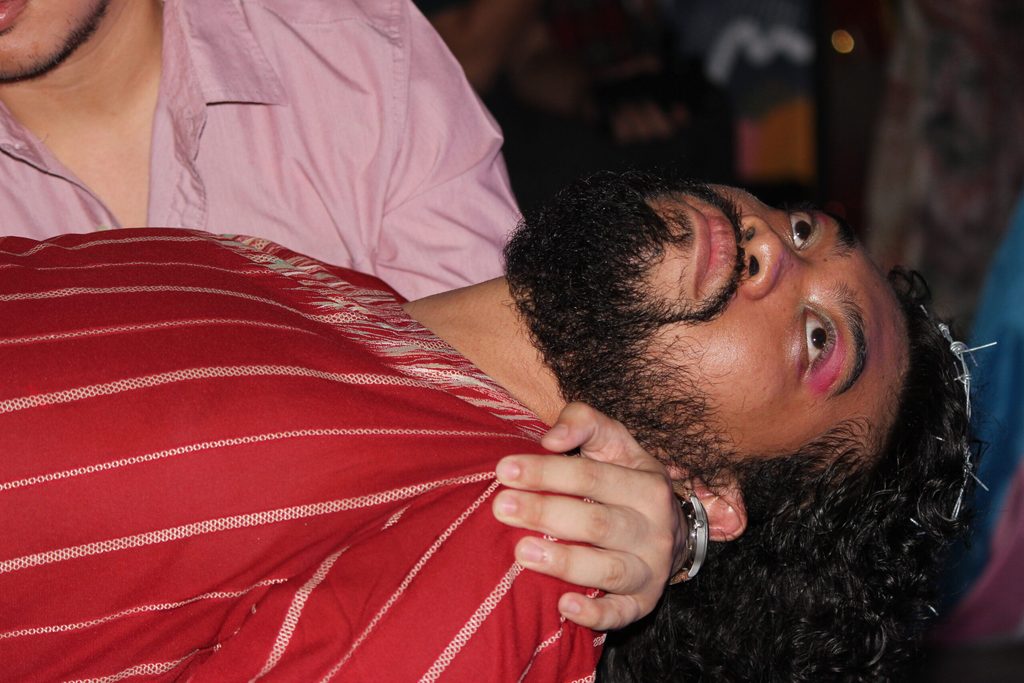
As a seminarian under formation to be a future priest, Keneth, on the other hand, emphasizes the disconnect between the Church’s teachings on empathy and the way some of its members expressed their opposition against the drag performer.
“After magmura sa comments section, some people believe they are doing a righteous thing. I know some Catholic friends who join in the rage online because merong urge na something perceived to be wrong needs to be corrected. Pero the thing about corrections is that if you don’t do it with charity and not preceded by an honest desire to listen, by the desire to bring about what’s good in your neighbor, it will be interpreted as an attack, and maybe it is.”
Radical understanding and empathy: #LoveWins and Love Thy Neighbor
The conversation between Floyd and Keneth went beyond the controversy that initially brought them together. It highlights the potential for meaningful discussions even in the face of deeply entrenched differences. It also serves as a reminder that in order to build a safer world, we must be willing to engage in conversations that challenge our beliefs, broaden our horizons, and lead us towards greater compassion and unity.
“Alam mo, some things should be really uncomfortable or disturbing for you to act. Some things, like growth, come out of discomfort,” Floyd probed, to which Keneth responded with, “Oo. So yung next na tanong sa atin when we acknowledge na uncomfortable yung video is: “What am I gonna do about it?”
For Floyd, “It’s been a long battle, pero there should be no battle at all kasi pareho lang naman ang gusto nating mangyari: to express who we are. I am saying this in no way dismissive of years and years of struggle dahil pinapatay pa rin tayo, tinatanggal sa trabaho, hindi pinapapasok sa CR, bawal gumamit ng mga public and social services. Imposibleng hindi natin ‘yun kilalanin.”
“Ama Namin is a beautiful prayer and ought to be preserved and protected from pambabastos. Pero if you dig deeper, yung text of the prayer kasi is not the end in itself. Prayers lead us to charity. Kung totoo ang kini-claim ko na ako ay Christian who grew up with all these prayers, ‘di ba dapat may mas malaki akong space, a bigger heart, to reach out and to understand?,” reflected Keneth.
“So bumabalik kasi ako doon sa when Jesus said “Love your neighbor”, hindi ka naman siguro mag-eexpect na yung neighbor mo looks like you, dresses the way you do, have the same beliefs and values that you do. That’s the point. You have to be charitable to your neighbor because of and in spite of who they are.”
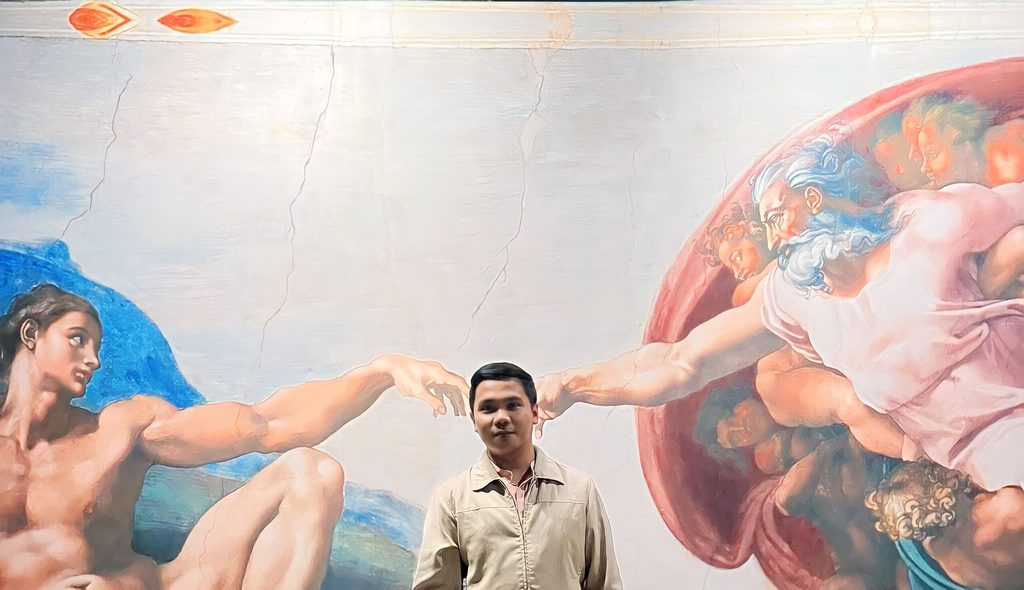
“Actually, ang ganda ng Love Thy Neighbor! I can be wrong pero the Catholic teaching revolves around “Love thy neighbor,” tapos sa LGBTQIA+ naman, “Love wins.” At the end of the day, it’s love eh. But the kind of love that really understands, respects, and defends each other’s rights, freedoms, and dignity. If walang ganung aspect ang pagmamahal, then it’s not love at all.
Mananalo lang ang love kapag mahal mo din ang taong hindi katulad mo. Ganun ko siya nakikitang bridge. Love only wins when you love your neighbor whose beliefs and ways of living happen to be different from yours.” Floyd concluded.
Many words are yet to be spoken, and perspectives from diverse backgrounds are yet to be laid bare about the multifaceted issue. But the conversation stands as a compelling testament to the power of respectful dialogue in forging connections across seemingly insurmountable gaps, finding common grounds between polarizing issues, and a possibility of radical love amidst inevitable differences. ###
—
DAKILA – Philippine Collective for Modern Heroism is an organization of artists, cultural and development activists, students, young professionals, and individuals creatively building a movement of heroism towards social transformation.


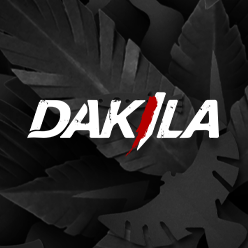
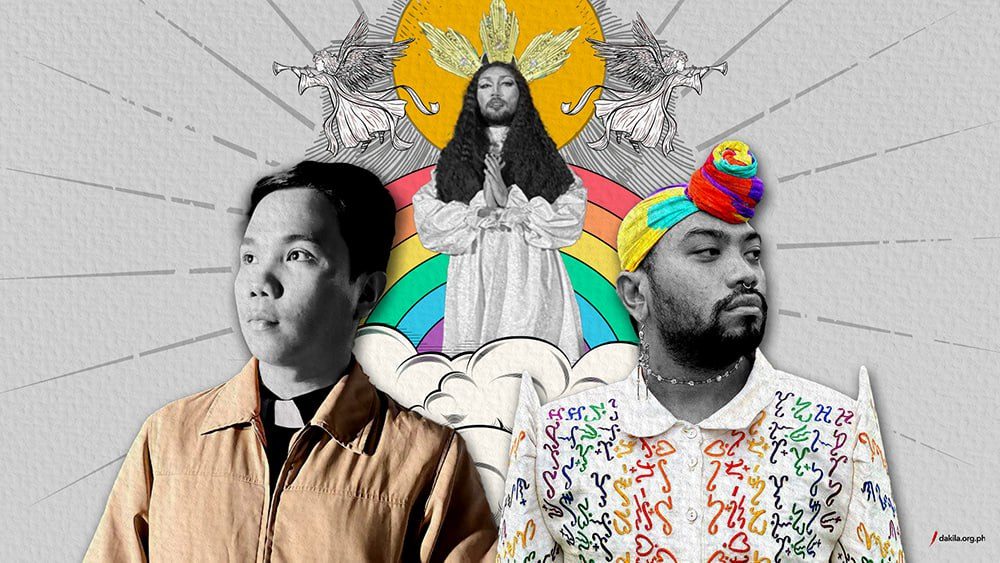
There are no comments yet. Add your comment to start the conversation.